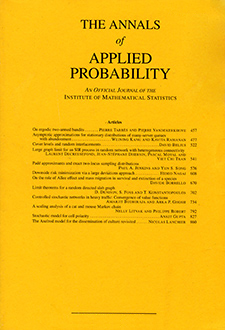Abstract
We consider a two-dimensional catalytic surface reaction between X and $Y_n$ with $Y_n + nX \to nXY$, where $Y_n$ is a polymer consisting of n identical atoms, each denoted by Y, and X is a monomer. The reactants X and $Y_n$ are present above the surface in a gaseous phase, and bond to the surface at certain rates. The resulting atoms X and Y on the surface react if they are sufficiently close to each other; the product XY then leaves the surface. A classical example is the oxidation of carbon monoxide on a platinum surface. In this case, $n = 2, X = CO$ and $Y_2 = O_2$. We consider the case in which the polymer consists of $n = N^2$ atoms, arranged in a square of length N, with N large. We show that when the range of interaction is large compared to the polymer size, X and Y will typically coexist on the catalytic surface for appropriate bonding rates. If, however, the range of interaction is small compared to the polymer size, then, irrespective of the bonding rates, the surface will eventually be fully occupied by the monomer X.
Citation
Maury Bramson. Claudia Neuhauser. "Coexistence for a catalytic surface reaction model." Ann. Appl. Probab. 7 (3) 565 - 614, August 1997. https://doi.org/10.1214/aoap/1034801245
Information





